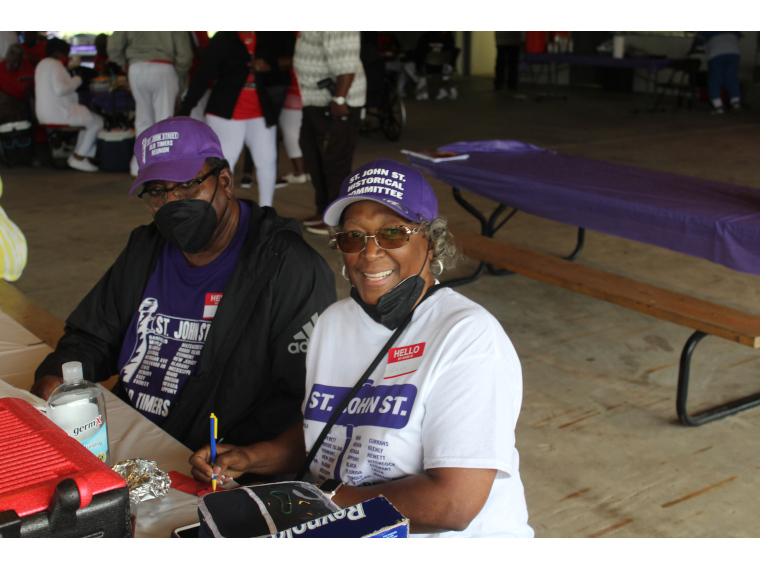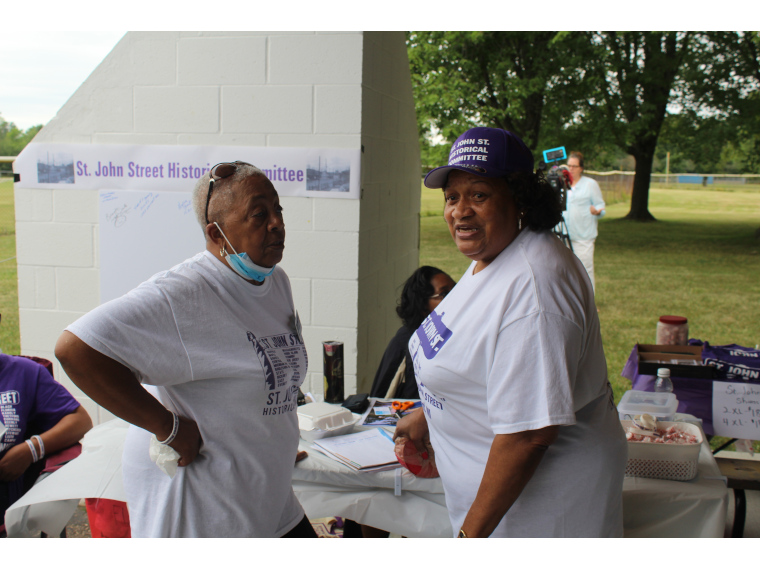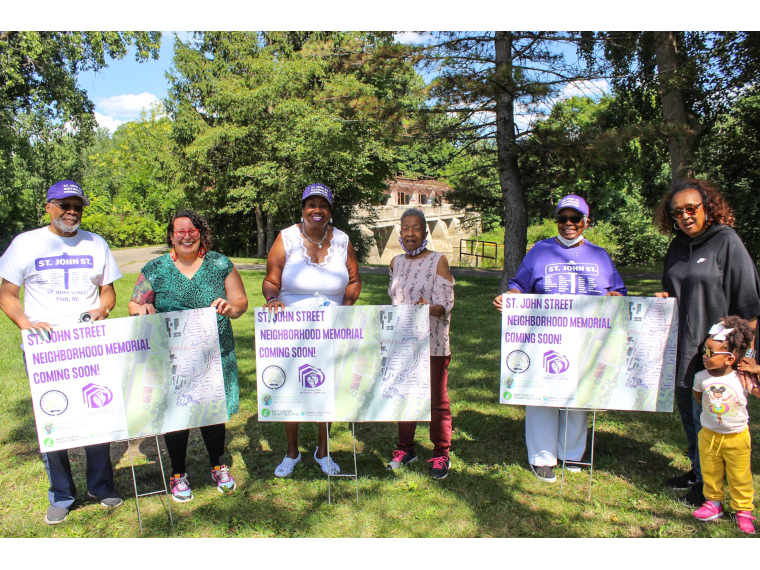Photos courtesy of St. John Street Historical Committee
Written by Tanya Terry
*A draft of Mayor Neeley and St. John Street Historical Committee’s St. John Neighborhood Memorial Plan was used for historical and site plan information.
82-year-old James Wardlow, president of the St. John Street Historical Committee, came to Flint with his parents from Tennessee in 1942. At the time, he was 2 years old. He was raised in the St. John Street area.
The St. John Street neighborhood was established in the late 1800s in north Flint, east of the former Buick City factory complex. It was a self-sustained community, where Blacks and some Eastern Europeans lived. The neighborhood boundaries were: north-Keenly Avenue, two blocks north of Stewart Avenue; south-Hamilton Avenue; east-the Flint River and west-Michigan Avenue, which once ran the length of Buick City, parallel to railroad tracks running along Buick City’s eastern boundary.
By the early 1900s, St. John was one of Flint’s two racially integrated neighborhoods without restrictive covenants that prevented people of color from buying and living in the homes.
Former residents recently shared fond memories of the neighborhood with the Courier at the Historic St. John Street Neighborhood reunion. The reunion returned Saturday, August 13, 2022 for the first time since 2019, before the COVID-19 pandemic hit.
Brenda Joyce Waits, a board member of the St. John Street Historical Committee who will turn 80 September 1, was born in the St. John St. area.
“I was born on Easy Street, and lived there until I was 5 or 6,” she said. “Then, I moved onto Oregon Street.”
Waits remembers living upstairs from her grandparents.
“We lived in a loft then, and that was back in 1940,” she said. “We had this one big room. I remember it was our living room and our bedroom-and our kitchen and bathroom with separate. The main thing I remember is people said we were poor, and I never knew we were poor. I never felt we were poor. We never were hungry. My mom was a clean freak. She kept me clean…Everybody had a garden. We didn’t have to leave our neighborhood for basically anything because we had everything there.”
Besides having fruits and vegetables in their backyard, Waits’ family had chickens in the yard.
“My grandma and my mom canned everything. It was a delightful time for me. I had a very happy childhood. I wasn’t stressed about anything.”
Waits is planning to write a book about the St. John Street area called “The Grape Vine.”
One place many considered a hub in the St. John Street neighborhood was the St. John Street Community Center. Those who went to the center would skate, play basketball and even have weddings there.
In 1975, the City of Flint repurposed the St. John Street Community Center for the Flint Police Training Academy.
The City of Flint Department of Community Development commissioned and implemented “urban renewal plans” to demolish thousands of homes and commercial buildings to make way for I-475 and the St. John Industrial Park. As a result, all families in the St. John neighborhood were displaced.
Wardlow said since so many families were displaced, he calls it “urban removal.”
“My parents and a lot of people’s parents and grandparents envisioned this ‘urban renewal,’ when it was presented to them, as the neighborhood revitalization,” Wardlow said. “What they saw was new homes being built in the area…and bringing the whole community up to date. But that’s not what the intent was. The intent was to come in and get these people out to get this land.”
Later, in 2021, the City of Flint sold the St. John Street Community Center to a commercial buyer-a marijuana processing company.
“The St. John Center is what spurred our action now,” Wardlow said. “When they sold the St. John Center, it told me, that when they did that they erased our history.”

So, the St. John Historical Committee shifted its energy from pursuing state registration of the Community Center as a historical site-a previous plan-to a larger memorial, evolving into a concept for a memorial park and other memorial features.
“I spoke to the mayor at the Juneteenth celebration last year. I approached him and told him how we felt about the sale of the St. John Street Center.”
After what Wardlow describes as a “very good meeting,” he said the mayor bought into their plan.
“He dedicated $250,000. He lent his Planning and Development Department to us and partnered with us to work out a plan.”
West Boulevard Park is the primary site identified for the memorial, running between W. Boulevard and the Flint River. According to Mayor Sheldon Neeley and St. John Street Historical Committee’s St. John Neighborhood Memorial Plan draft, the park was enjoyed by St. John residents when it was at its peak. Some of the key design principles and elements listed in the plan include developing essential elements including a historical marker plaque like the one in Chevy Commons, a large pavilion and a memorial walking path with features like historical signs, benches and statues. The art installation will engage park users in learning about community leaders who grew up in the St. John neighborhood through at least 11 statues. The visual design of a multi-generational playground will be themed to mimic buildings from the St. John Street neighborhood. Massachusetts Dam needs to be removed and replaced with a walking bridge to connect the neighborhoods, according to the plan draft. The plan states the City of Flint’s current American Rescue Plan Act (ARPA) funds for infrastructure improvement offers a perfect funding source to achieve such an infrastructure improvements. A historical mural covering graffiti on the W. Boulvard Drive retaining wall for I-475/Leith Street Bridge is also planned.

Wardlow said he was very pleased with the reunion, despite the minor effect the cooler weather had on the size of the crowd. He said a lot of the committee’s efforts are now focused on the memorial park in order to preserve the memory and rich history of the St. John Street neighborhood, and they have received a lot of support for it.


